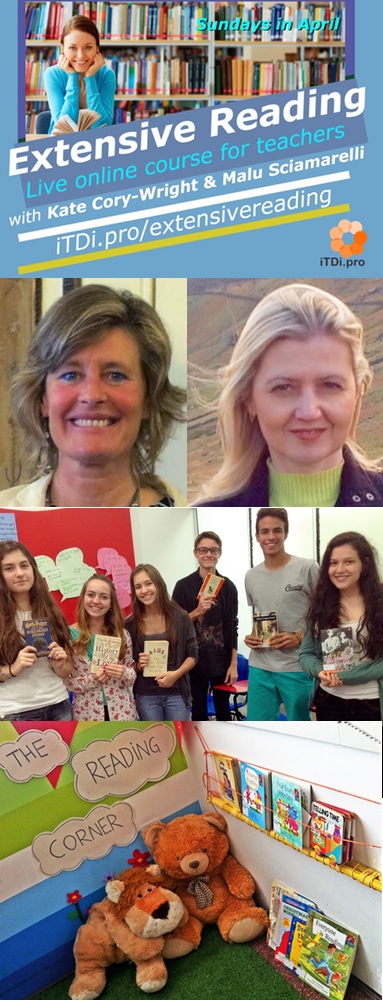
By Kate Cory-Wright
Seven Tips for Motivating Reluctant Readers
Extensive Reading is often defined as “reading a large amount of books for pleasure.” Sorry? Did someone say “reading” and “pleasure” in the same sentence?
Personally, I can’t think of a better way to spend an evening than curling up with a book. I can’t think of a better way to improve my foreign languages than by reading. Reading is pleasure for me. However, I recognise that for many students, reading is about as boring and alien as boxing or wrestling is to me. So how can we foster a love of reading in students who are reluctant? The following tips are based on my experiences of extensive reading with tweens and teens over the years.
- Consider your method.
The only time my school teachers successfully put me off reading was when we all had to read the same book and classes were spent analysing it to death, completing worksheets, etc. Is this the way to foster a love of reading in a reluctant reader? Unlikely. In fact, that is intensive reading, not extensive reading. Nowadays I have developed a method that treats the books like movies that students can watch in their free time. In other words, reading is:
- optional;
- not accompanied by tests or worksheets;
- students’ responsibility: they choose what, when, and how to read. If they don’t like the book they have chosen, they can abandon it and try another, just as they would change channels if the movie was unappealing.
So, how does this work in reality? Six months ago, I introduced my students to extensive reading. After explaining the benefits, I invited them to choose a book from my library and reminded them that it was optional to borrow a book. A few students took the lead. They chose books because they wanted to read. Others followed suit, slightly hesitantly. The last two students shook their heads and said “No, thank you.” My response? No comments, no persuasion. Their peers did the job for me! After two weeks of watching their classmates bring back books and borrow more, the last two decided to participate. It was their choice. One of those two is now the most avid reader in the class.
2. Provide Variety.
To foster the habit, students need to read a lot of books. But which books? Before now, I’ve made the mistake of choosing for them, but I failed. I remember suggesting a James Bond reader for Brandon, a 13-year-old student. He pulled a horrible face and instead chose a book about an Indian girl who gets sold into slavery! One tendency I have noticed over the years is that teens often borrow “information” books. At the British Council, we had a huge selection of genres, but the fantasy, mystery, sci-fi, romance, and adventure books often went untouched. Many teenagers preferred to read about nature, planets, history, etc. You can of course make suggestions, but be prepared for students to turn their nose up at your notion of “interesting.”
Since we have no idea what they will enjoy, variety is the key. Offer plenty of genres and topics. Readers are not the only option: try magazines, multiple-path books (see Atama-ii books), plays, audio books, ebooks, etc. Old books are fine, too. My students often choose “Tintin”, even though it is an old dog-eared comic book from my childhood!
- Easy does it.
Christine Nuttall suggests using the SAVE rule to promote reading. Offer students books that are Short, Appealing, Varied, and Easy. The focus here is EASY. If students struggle with unknown words in every paragraph, they are likely to give up. In intensive reading, we tend to study books that are higher than the students’ level. Extensive reading is the opposite. Easy does it. My current group of students uses the “five finger rule”: they choose a random page and spot how many words they don’t know. If it exceeds five, then it is probably not the right level for them.
- Your role.
If you are an avid reader, your students can pick up the habit from you. Tell your students about the wonderful things that they will gain from extensive reading, be a model. If students ever read in class, read a book yourself. Read the students’ books, too. And from time to time, show students a book that you’re reading. Spread the joy!
- Be creative.
Creating reading games or challenges can promote reading to reluctant students. For example, students who need some extrinsic motivation might enjoy reading their way through a bingo card. This way, they can feel their progress. Younger learners like to draw pictures and make dioramas, based on the book. Older learners enjoy technology, for example they can “pin” the book, or adapt their reading to a social activity.
Note: we do not need to provide post-reading activities. In the words of Bamford and Day (1998), the best post-reading activity is to read another book!
- Celebrate reading.
Children across the world celebrate books on World Book Day in March, but why only March? Choose your event and consider a fun activity:
* Dress up as a character from your favourite book. Take selfies, holding the book.
* Visit a bookstore to buy your first ever book or get your first card from a library.
* Hold a book fair (you can even raise money for the library).
* Make food and drink for a party. Name the food items after people in the books.
* Act out a scene from a book with your reading buddy.
- Trust your students
Marco is a 12-year-old student who sometimes fools around in my English classes, so I admit that I secretly doubted he was reading the books that he borrowed. Until one day there was a knock at the door… The man standing there, dressed in building overalls, introduced himself as Marco’s father. As we talked, I learned that he was illiterate but thanks to Marco he was learning to read. He was almost in tears as he described how he and Marco regularly read books on the sofa together in the evenings. I was almost in tears myself. Marco was not only reading, he was helping his father to read. How had I underestimated him so badly?
For many teachers, giving students the freedom to read with no post-reading task or test is an odd concept because it requires trust. “But how will I know if they are really reading the book?” teachers ask. The fact is, you don’t. School is full of tests. Extensive reading is a rare occasion when kids can do something for pleasure.
Wishing you every success and happiness in your extensive reading!
Sources
Bamford and Day (1998): Extensive Reading in the Second Language Classroom
Nuttall, C. (1996): Teaching Reading Skills in a Foreign language
If you would like to learn more about extensive reading, you are cordially invited to join an iTDi Advanced Course in April. “The Power and the Joy of Extensive Reading” will be run by Malu Sciamarelli and Kate Cory-Wright. During the 4-week course, we will cover: extensive reading, setting up and running a reading program, and setting up a library.








